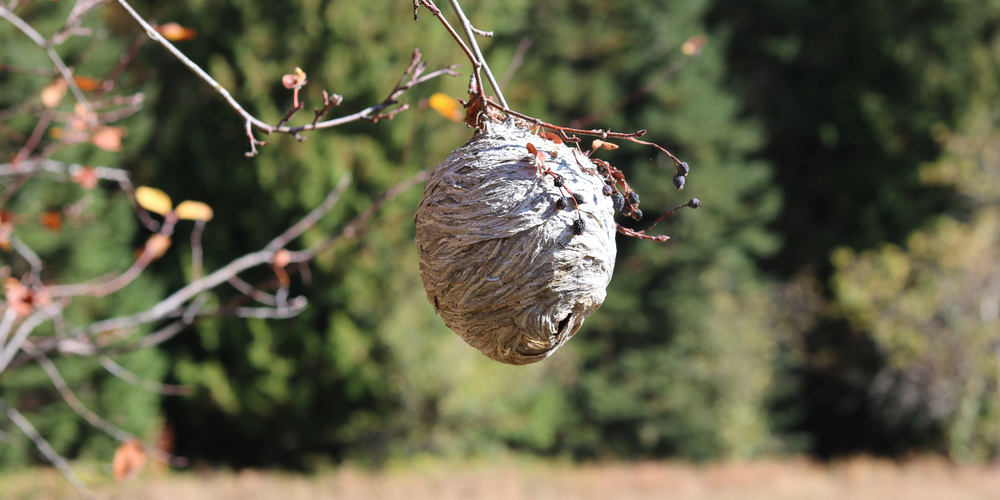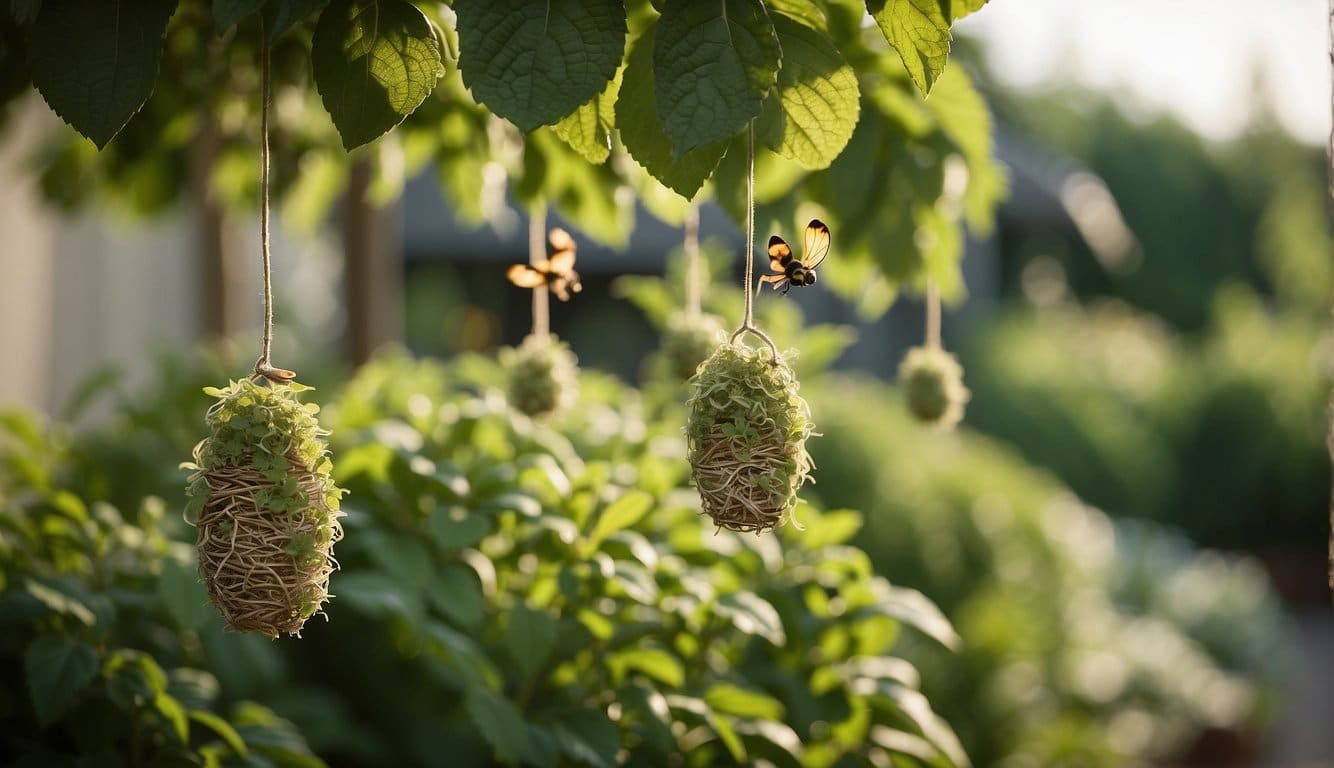Wasp Nest Identification
Before you can deal with wasps, you need to be able to spot their homes.
Knowing what you’re looking at could save you from a stinging surprise!
Types of Wasps and Their Nests
- Paper Wasps: Your typical umbrella-shaped nest is the artwork of paper wasps.
Crafted from chewed wood fibers mixed with saliva, these nests often resemble an open-faced honeycomb and are found hanging from tree branches or eaves.
- Common Species: Polistes dominula (European paper wasp), Polistes fuscatus (Northern paper wasp)
- Yellowjackets: These nests can grow to the size of a basketball and are usually hidden away from view.
You might find them underground or in a dark, enclosed area. Their nests appear as layered sheets and are enveloped in a papery covering.
- Common Species: Vespula germanica (German yellowjacket), Vespula vulgaris (Common yellowjacket)
- Hornets: Hornets are famous for their large, football-shaped nests.
Starting from high places like tall trees or the sides of buildings, these nests are constructed from a similar paper-like material that their relatives use.
- Common Species: Vespa crabro (European hornet), Dolichovespula maculata (Bald-faced hornet)
Wasp Nest Locations
- Aboveground: You’ll often find nests in the crooks of branches or eaves. Keep an eye out on:
- Trees: Look for nests in forks or hollows.
- Buildings: Nests favor gable vents, soffits, and even attic rafters.
- Bushes: Dense foliage can hide these papery dwellings.
- Belowground: Surprise! Yellowjackets especially fancy underground real estate. Watch for:
- Rodent Burrows: Abandoned holes make cozy homes for these wasps.
- Landscapes: Mulched flower beds and grassy borders are prime sites.
- Inside Structures: Wasps aren’t shy about moving in with you. Areas to inspect are:
- Garages and Sheds: Lesser-used areas are safe havens for nest building.
- Wall Voids: A crack or crevice is all they need to start construction inside your walls.
Preventive Measures
Before you start planning your next outdoor BBQ, let’s go over some clever wasp-dodge maneuvers.
Keep in mind, a stitch in time saves nine, especially when dealing with these buzzy invaders.
Securing Food Sources
- Cover Up: When you’re dining al fresco, keep your nibbles under wraps.
- Use food covers or sealed containers to ward off any wasp scouts.
- Clean Sweep: Post-picnic, give the area a once-over with soapy water to wipe away any food remnants that may lure wasps to your locale.
Wasp-Repelling Plants
- Mint Magic: Plant some mint. Wasps are not fans of this cool herb, so it’s your garden’s gain and their loss.
- Spicy Deterrents: Grow spicy-scented plants like eucalyptus and citronella.
- These plants double as natural wasp repellents — and they smell great to humans!
Home Maintenance Tips
- Crackdown: Scout for and seal any cracks in your home’s exterior – a favorite hidey-hole for wasps to nest.
- Water Watch: Maintain a leak-free household because excess moisture is a big attraction for these stingers.
- Regularly check for and repair any plumbing leaks.
Safe Nest Removal
Removing a wasp nest can be a tricky business, but getting rid of these stingers doesn’t have to sting you back if you do it right. Here’s how you can safely say goodbye to those unwelcome nesters.
DIY Removal Methods
- Wait for the Right Time: Tackle the nest either early in the morning or late at night when wasps are less active.
- Dress Appropriately: Cover up with long sleeves, pants, gloves, and a hat to minimize exposed skin.
- Using Sprays:
- Find a wasp-killing pesticide and follow the directions carefully.
- Spray the nest thoroughly, aiming directly at the entrance for maximum effect.
- Alternative Approaches:
- Mix water and peppermint oil in a spray bottle for a natural deterrent.
- For ground nests, consider dousing the nest with white distilled vinegar.
- Learn how to make your own natural repellent.
Professional Extermination
- Seek Expertise: If the nest is too large or you’re allergic, contact a professional wasp removal service.
- Consider Safety: Pros have the right gear and experience to handle the nest without causing a frenzy.
- What to Expect:
- The exterminator will inspect the situation and determine the best course of action.
- They’ll often use specialized equipment to remove the nest and make sure it’s done without endangering you or your property.
After Removal Care
- Stay Vigilant: Keep an eye out for any returning wasps, as they may try to rebuild.
- Repair and Seal: Fix any holes or entrances where wasps gained access to prevent future infestations.
- Preventative Measures:
- Remove food sources like open garbage and pet food from your outdoor areas.
- Consider placing decoy nests or planting wasp-repellent plants such as mint, eucalyptus, and citronella around your home.
Natural Wasp Deterrents
Facing the buzz of wasps outdoors? You’re in luck! Natural wasp deterrents can make your space a no-fly zone for these sting-happy insects. Let’s break them down:
- Soap & Water Spray:
- Mix 2 tablespoons of dish soap with water in a spray bottle.
- Apply liberally on small nests to suffocate wasps. (The Spruce)
- Essential Oils:
- Wasps don’t fancy the scent of certain oils, like peppermint, eucalyptus, and clove.
- Create a mixture and distribute around your outdoor areas.
- Sugar & Water Traps:
- Combine sweetened water in a bottle with a narrowing top.
- Wasps enter for a treat and can’t escape. (How to get rid of wasps — Tom’s Guide)
- Grow Repellent Plants:
- Cultivate wasp-averse flora such as spearmint, thyme, and citronella.
- These plants naturally repel wasps, enhancing your garden’s defenses.
Wasp Sting First Aid
If you’re on the wrong end of a wasp sting, fear not! Just follow these upbeat and handy first aid steps to get you back to your outdoor adventures with minimal fuss:
Act Quickly
- Remove any stingers immediately. A credit card or dull blade can do the trick by scraping it across the sting area.
Reduce Swelling and Pain
- Apply ice or a cold pack to the sting site to calm that angry welt.
- Wrap your cold source in a cloth and keep it on for 10 minutes, off for 10, and repeat.
Neutralize the Sting
- Some swear by vinegar, while others prefer baking soda. Pick your fighter:
-
- For acidic venom, dab a bit of vinegar onto the area.
- For alkaline venom, a baking soda paste (3 parts baking soda, 1 part water) works wonders.
Over-the-Counter Helpers
- Ibuprofen or acetaminophen can be your allies against pain.
- Antihistamines are great for beating back the itchiness.
Allergy Check
- Be alert for more severe reactions, like difficulty breathing or swelling of the face and throat.
- If this happens, seek medical attention immediately.
Prevention Post-Sting
- Keep the area clean and watch for signs of infection, like increased redness or pus.
- Avoid scratching to prevent infection.
Remember, wasps usually sting defensively, so give them space to buzz away.
If you’re looking for products to help soothe the sting, check out options available on Amazon or perhaps find what you’re looking for on eBay.
Frequently Asked Questions
Having trouble with wasps? You’re not alone. Here’s the buzz on the most common queries about handling those pesky insects with precision and care.
What’s the best natural repellent to keep wasps at bay?
To deter wasps naturally, mix peppermint oil with water and spray it around your home. Wasps dislike the scent of peppermint, and it serves as an effective repellent.
In the case of an invisible nest, how can one deter wasps?
Use a combination of clove, geranium, and lemongrass essential oils. Apply this blend around areas where you suspect wasps might be entering, such as eaves and cracks in siding.
What steps can I follow to evict wasps from my home without harm?
- Ensure all food and sugary drinks are covered or indoors, eliminating attraction factors for wasps.
- Hang decoy nests, as wasps are territorial and typically avoid areas they believe are already inhabited.
Is there a DIY method for safely dismantling a wasp’s nest indoors?
Yes, but proceed with caution. At night, when wasps are less active, cover the nest in a heavy garbage bag, seal it, and freeze or dispose of it.
Can you reveal eco-friendly tactics for neutralizing a wasp nest inside a wall?
Injecting a mixture of soap and water into the nest’s entrance can effectively neutralize it. The soap clogs their breathing pores and the wasps expire naturally.
Plant wasp-repelling plants such as wormwood, basil, and marigolds around your property to create a natural barrier against wasps setting up shop near your home.
Last update on 2025-06-06 / Affiliate links / Images from Amazon Product Advertising API




